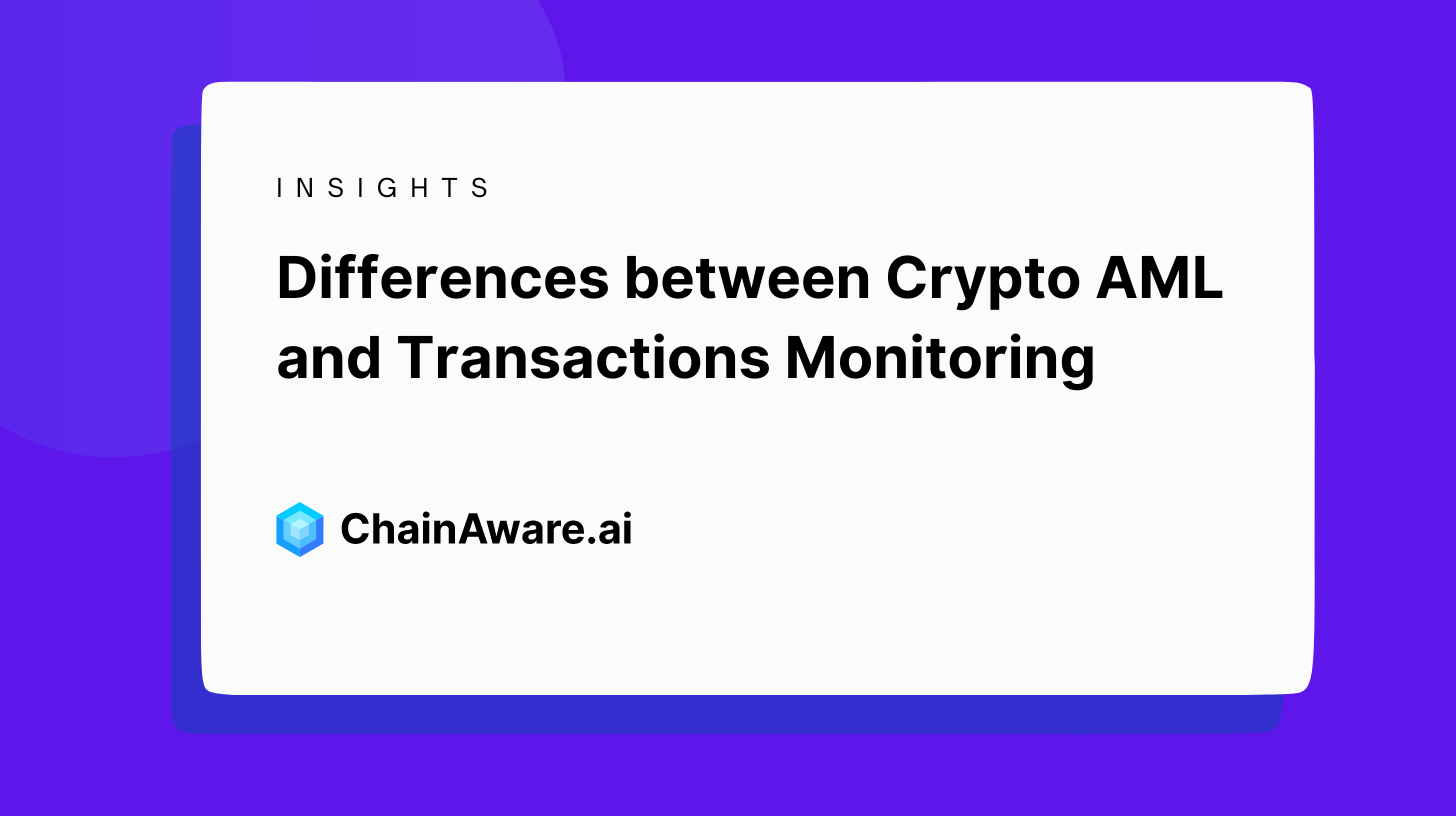Virtual Asset Service Providers must do Crypto AML, KYC, and KYB (Know Your Business). Additionally, the law requires companies to do Crypto Transactions Monitoring.
KYC is about verifying the client’s identity. KYC and KYB processes are well known – tons of literature about how to do this properly are available. Let’s add a summary:
- KYC is about identifying individuals’ identity
- KYB is about confirming the business’s identity, identifying the company’s directors, and knowing the company’s business segment.
The focus of this article is on the following:
- AML requires crypto service providers to validate the source of the funds, i.e., that the funds are “white” declared money. The mandate of AML is not to let the “black” money into circulation.
- Transactions Monitoring requires verifying the transactions and not executing fraud. The key idea is not to let the scam happen at all. Probably most of us know the situations where we are traveling and receive phone calls from credit card providers, which validate our transactions. These are examples of flagged transactions by Transactions Monitoring. These systems are usually based on Artificial Intelligence – because fraudsters are pretty innovative.
What is Crypto AML?
Crypto AML – Anti Money Laundry – focuses on the verification that the money has been received from legal and declared sources. This is called then “white money.” The opposite of white money is “black money” – the money obtained from criminal activities or un-declared in the tax declarations.
AML’s task is to let only the white money into financial service providers.
But is the AML relevant – yes, U.N. estimates the yearly money laundry flows at 2.7% of global GDP.
Crypto AML’s task is not to identify fraud but to identify only that the money is from legal sources. This means if someone has “white” money and plans to fraud someone, then that’s not the task of the crypto AML.
What is Crypto Transactions Monitoring?
Transactions monitoring monitors clients’ transactions in real-time; its task is:
- detecting fraud and
- preventing fraud
Every transaction in traditional financial institutions is routed through real-time transaction monitoring. Transactions are rejected or added into so-called “clarification queues,” where clients must supply additional information.
Traditional finance has risk scores for every client – some clients are involved in high-risk activities (in AML terminology), and others are not. High-risk activities translate into higher risk scores. Clients with higher risk scores have tighter monitoring and vice versa.
Transactions monitoring is usually artificial intelligence-based and uses a broad spectrum of inputs. Traditional finance has a lot of data inputs into A.I. algorithms (personal data, related data, device data, etc.). All this data is then analyzed in real-time for the transacting clients.
The issue in the Crypto Transactions Monitoring is that only a blockchain address and no additional info are available. This means the decisions about potential fraud can be made only based on two transacting addresses.
Some platforms offer forensic analytics products for this, but this is not enough – it’s not enough to measure the distance for the “known bad addresses” because the fraudster usually does not interact with the known bad addresses. And usually, every fraud is different – while forensic analytics can help, it’s not enough. Or let’s say – all transaction monitoring systems in traditional finance are AI-based.
How does Crypto AML differ from Crypto Transaction Monitoring?
While Crypto AMLand Crypto Transactions Monitoring is designed to prevent financial crimes in the crypto industry, they each serve a slightly different purpose.
- Crypto AML is focused on identifying and mitigating the risks of money laundering.
- Crypto Transactions Monitoring is focused on analyzing the flow of funds to detect suspicious activities.
The AML focuses on identifying the sources of the funds and avoiding non-clean money entering circulation. Transaction Monitoring focus is on the identification of fraud patterns by analyzing the flow of funds.
How to use AI-based Crypto Fraud Detection for Crypto Transactions Monitoring?
ChainAware.ai AI-based Crypto Fraud Detection API can be used to verify incoming and outgoing transactions. For example, crypto businesses could use this API in the following way:
- If receiving transactions from other addresses, then the platform should call the Crypto Fraud Score API on these addresses
- If sending transactions to other addresses, then the platform should call the Crypto Fraud Score API before sending transactions to them.
The current predictive power of AI-based Crypto Fraud Detection is 98%. This means the algorithm predicts correctly in 98 cases of 100 fraud. It’s not a forensic algorithm based on already listed “bad” addresses or other forensic analytics outputs, but it’s a predictive algorithm based on the address interaction patterns.
Crypto Fraud Score is calculated in real-time based on the transaction history of a given address. It supports Ethereum, Polygon, and Binance Smart Chain.
But how is it possible to identify 98% based on blockchain data only? There are unlimited potential scams or frauds. But scammers are using specific interaction patterns stored in their transaction history on the blockchain. Our artificial intelligence modules identify these interaction patterns and forecast the future behaviors of the addresses based on past interaction patterns.
This offers then Crypto Transaction Monitoring capability for both:
- for the CeFi companies and
- for the DeFi companies
CeFi companies can verify the addresses before submitting the transactions. DeFi companies can choose which wallets they let connect to their Dapp.
Summary
By identifying and mitigating the risks of financial crimes and monitoring the flow of funds across the blockchain, crypto businesses can protect themselves and their customers from fraud and other illicit activity.
Most of the crypto businesses have focused on the Crypto AML. However, Crypto Transactions Monitoring is regulatory mandated too. One of the reasons could be that many tools are available for the Crypto AML, but much fewer tools are available for Crypto Transactions Monitoring.
ChainAware.ai offers AI-based solutions for Crypto Transactions Monitoring. The AI models are trained with the fraud behavior and addresses, allowing the machine learning algorithms to identify new scams and frauds in real time.
Additional Info
- Forensic Analytics versus AI-based Crypto Analytics
- SmartCredit.io integrates AI-based Transaction Monitoring and Big Data Analytics
- Predictive AI-based Crypto Fraud Detection launched!
- Can AI be used for Cypto KYC, Crypto AML, and Crypto Transaction Monitoring?
- Twitter: https://twitter.com/CryptoTrust_ai
- Twitter: https://twitter.com/smartcredit_io




